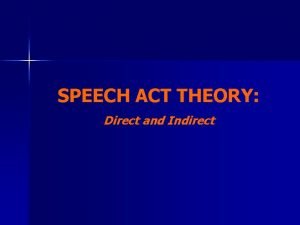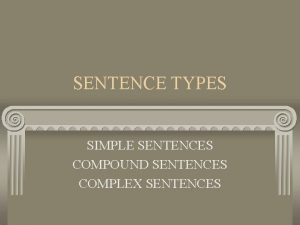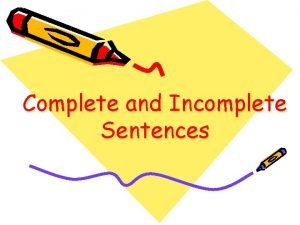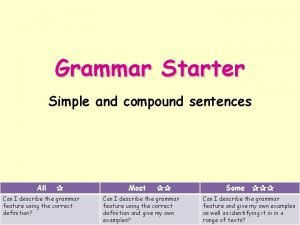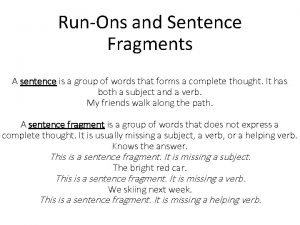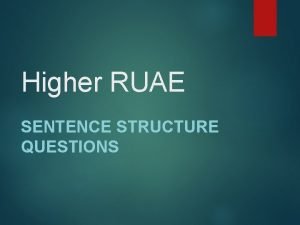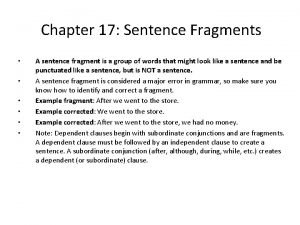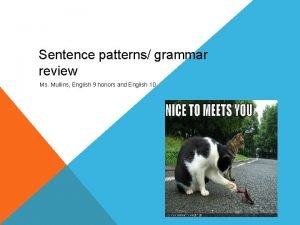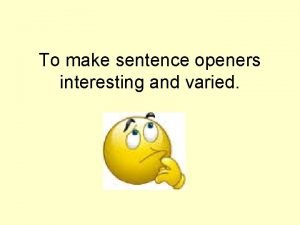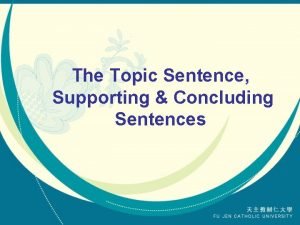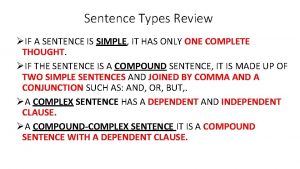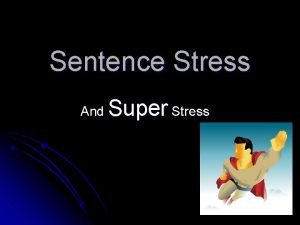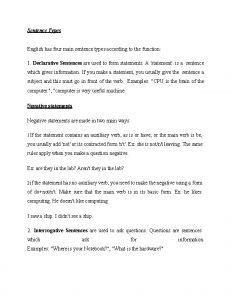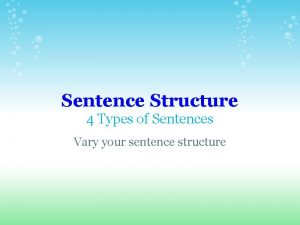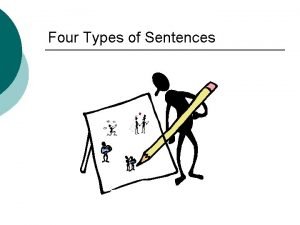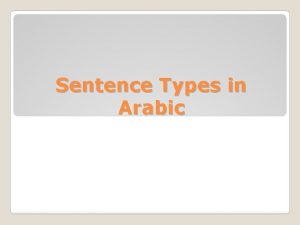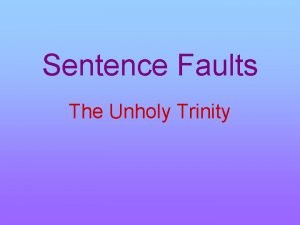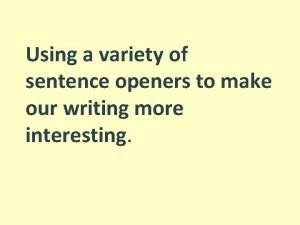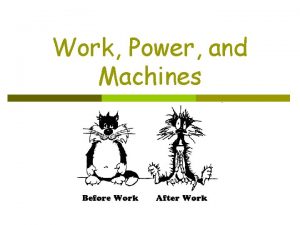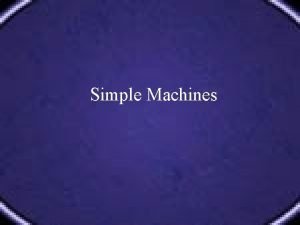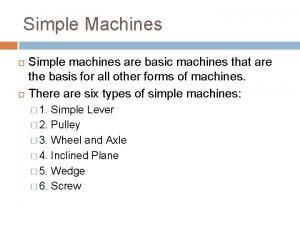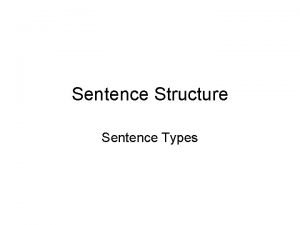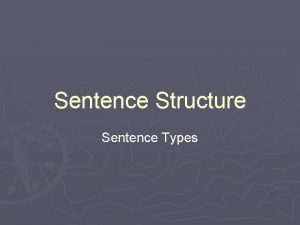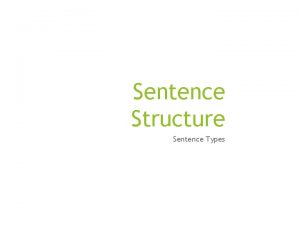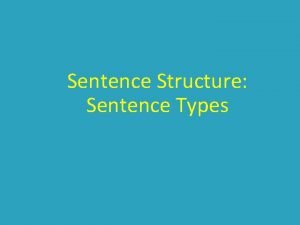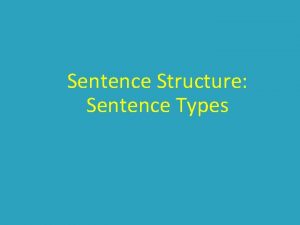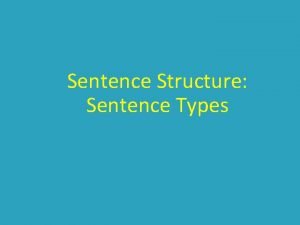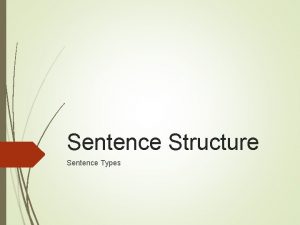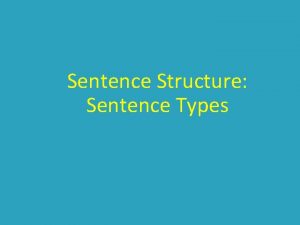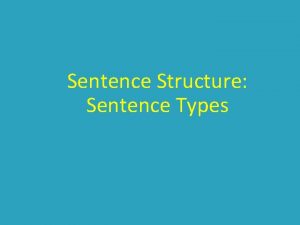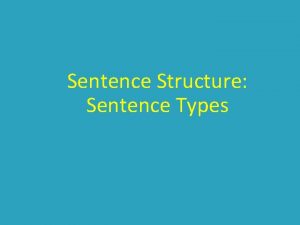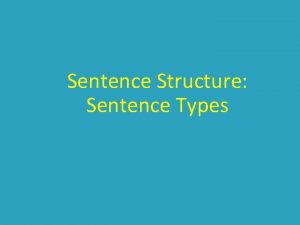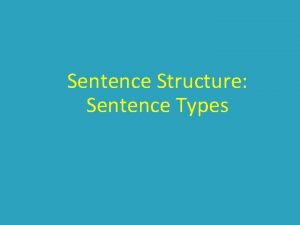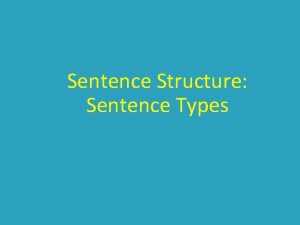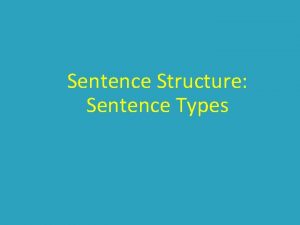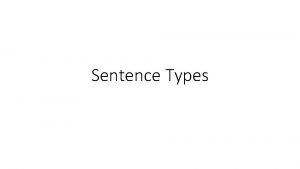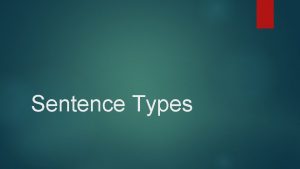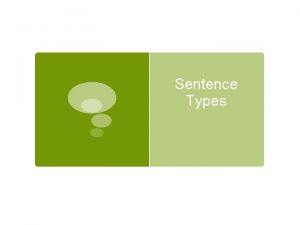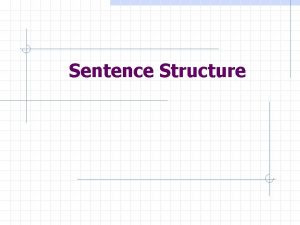Sentence Types I Simple Sentence I Simple Sentence


































- Slides: 34

Sentence Types

I. Simple Sentence

I. Simple Sentence A. A simple sentence is one independent clause by itself.

I. Simple Sentence A. A simple sentence is one independent clause by itself. B. Examples: 1. My mother belongs to a club.

I. Simple Sentence A. A simple sentence is one independent clause by itself. B. Examples: 1. My mother belongs to a club. 2. Argentina and Chile are in South America.

I. Simple Sentence A. A simple sentence is one independent clause by itself. B. Examples: 1. My mother belongs to a club. 2. Argentina and Chile are in South America. 3. James read Stuart Little and reported on it.

I. Simple Sentence A. A simple sentence is one independent clause by itself. B. Examples: 1. My mother belongs to a club. 2. Argentina and Chile are in South America. 3. James read Stuart Little and reported on it. II. Compound Sentence A. A compound sentence has two or more independent clauses that are joined by a comma and a connecting word.

B. In compound sentences, a conjunction connects the sentences.

B. In compound sentences, a conjunction connects the sentences. C. A comma comes before the conjunction.

B. In compound sentences, a conjunction connects the sentences. C. A comma comes before the conjunction. D. Examples: 1. I forgot my lunch, but dad ran to the bus with it.

B. In compound sentences, a conjunction connects the sentences. C. A comma comes before the conjunction. D. Examples: 1. I forgot my lunch, but dad ran to the bus with it. 2. She likes sweets, yet she seldom eats them.

B. In compound sentences, a conjunction connects the sentences. C. A comma comes before the conjunction. D. Examples: 1. I forgot my lunch, but dad ran to the bus with it. 2. She likes sweets, yet she seldom eats them. E. Sometimes the independent clauses in a compound sentence are joined by a semi-colon ( ; )

B. In compound sentences, a conjunction connects the sentences. C. A comma comes before the conjunction. D. Examples: 1. I forgot my lunch, but dad ran to the bus with it. 2. She likes sweets, yet she seldom eats them. E. Sometimes the independent clauses in a compound sentence are joined by a semi-colon ( ; ) F. If they are joined by a semi-colon, do not use a connecting word.

G. Examples: 1. The blue one is mine; it has my initials on it.

G. Examples: 1. The blue one is mine; it has my initials on it. 2. A spider is not an insect; it is an arachnid.

G. Examples: 1. The blue one is mine; it has my initials on it. 2. A spider is not an insect; it is an arachnid. III. Complex Sentence A. A complex sentence has one independent clause and one or more dependent clauses.

G. Examples: 1. The blue one is mine; it has my initials on it. 2. A spider is not an insect; it is an arachnid. III. Complex Sentence A. A complex sentence has one independent clause and one or more dependent clauses. B. The dependent clause can be at the beginning, middle, or end of the sentence.

G. Examples: 1. The blue one is mine; it has my initials on it. 2. A spider is not an insect; it is an arachnid. III. Complex Sentence A. A complex sentence has one independent clause and one or more dependent clauses. B. The dependent clause can be at the beginning, middle, or end of the sentence. 1. Before Amy planted the garden, she made a sketch of the layout.

G. Examples: 1. The blue one is mine; it has my initials on it. 2. A spider is not an insect; it is an arachnid. III. Complex Sentence A. A complex sentence has one independent clause and one or more dependent clauses. B. The dependent clause can be at the beginning, middle, or end of the sentence. 1. Before Amy planted the garden, she made a sketch of the layout. Dependent: Before Amy planted the garden

G. Examples: 1. The blue one is mine; it has my initials on it. 2. A spider is not an insect; it is an arachnid. III. Complex Sentence A. A complex sentence has one independent clause and one or more dependent clauses. B. The dependent clause can be at the beginning, middle, or end of the sentence. 1. Before Amy planted the garden, she made a sketch of the layout. Dependent: Before Amy planted the garden Independent: she made a sketch of the layout.

2. When bees collect pollen, they pollinate the plants they visit.

2. When bees collect pollen, they pollinate the plants they visit. Dependent: When bees collect pollen

2. When bees collect pollen, they pollinate the plants they visit. Dependent: When bees collect pollen Independent: they pollinate the plants Dependent: they visit.

2. When bees collect pollen, they pollinate the plants they visit. Dependent: When bees collect pollen Independent: they pollinate the plants they visit. IV. Compound-Complex Sentences A. A sentence with two or more independent clauses and at least one dependent clause is a compound-complex sentence.

B. Examples: 1. I picked up the branches that had fallen during the storm, and Rosa mowed the grass.

B. Examples: 1. I picked up the branches that had fallen during the storm, and Rosa mowed the grass. Independent: I picked up the branches

B. Examples: 1. I picked up the branches that had fallen during the storm, and Rosa mowed the grass. Independent: I picked up the branches Dependent: that had fallen during the storm

B. Examples: 1. I picked up the branches that had fallen during the storm, and Rosa mowed the grass. Independent: I picked up the branches Dependent: that had fallen during the storm Independent: Rosa mowed the grass Connecting: , and

Practice! Identify each of the sentences as simple, complex, compound, or compound-complex. 1. Cuba’s capitol is Havana, and this beautiful city has been the center of Cuban culture since 1552. 2. The heavy branches of the oak tree hung over our table and shaded us from the sun. 3. Because opinions are still divided, further discussion is needed. 4. The clock’s minute hand stopped working, but the second hand still moves. 5. Seashells filled her suitcase and spilled onto the floor.

Practice! Identify each of the sentences as independent, complex, compound, or compoundcomplex. 1. Cuba’s capitol is Havana, and this beautiful city has been the center of Cuban culture since 1552. (Compound) 2. The heavy branches of the oak tree hung over our table and shaded us from the sun. 3. Because opinions are still divided, further discussion is needed. 4. The clock’s minute hand stopped working, but the second hand still moves. 5. Seashells filled her suitcase and spilled onto the floor.

Practice! Identify each of the sentences as independent, complex, compound, or compoundcomplex. 1. Cuba’s capitol is Havana, and this beautiful city has been the center of Cuban culture since 1552. 2. The heavy branches of the oak tree hung over our table and shaded us from the sun. (Simple) 3. Because opinions are still divided, further discussion is needed. 4. The clock’s minute hand stopped working, but the second hand still moves. 5. Seashells filled her suitcase and spilled onto the floor.

Practice! Identify each of the sentences as independent, complex, compound, or compoundcomplex. 1. Cuba’s capitol is Havana, and this beautiful city has been the center of Cuban culture since 1552. 2. The heavy branches of the oak tree hung over our table and shaded us from the sun. 3. Because opinions are still divided, further discussion is needed. (Complex) 4. The clock’s minute hand stopped working, but the second hand still moves. 5. Seashells filled her suitcase and spilled onto the floor.

Practice! Identify each of the sentences as independent, complex, compound, or compoundcomplex. 1. Cuba’s capitol is Havana, and this beautiful city has been the center of Cuban culture since 1552. 2. The heavy branches of the oak tree hung over our table and shaded us from the sun. 3. Because opinions are still divided, further discussion is needed. 4. The clock’s minute hand stopped working, but the second hand still moves. (Compound) 5. Seashells filled her suitcase and spilled onto the floor.

Practice! Identify each of the sentences as independent, complex, compound, or compoundcomplex. 1. Cuba’s capitol is Havana, and this beautiful city has been the center of Cuban culture since 1552. 2. The heavy branches of the oak tree hung over our table and shaded us from the sun. 3. Because opinions are still divided, further discussion is needed. 4. The clock’s minute hand stopped working, but the second hand still moves. 5. Seashells filled her suitcase and spilled onto the floor. (Simple)
 Direct speech act examples
Direct speech act examples Compound sentence formula
Compound sentence formula Formal topic sentence
Formal topic sentence Types of incomplete sentences
Types of incomplete sentences Sentence definition
Sentence definition Present simple and future simple
Present simple and future simple Past simple future simple
Past simple future simple Simple past simple present simple future
Simple past simple present simple future Present continuous past continuous future continuous
Present continuous past continuous future continuous Simple past simple present simple future
Simple past simple present simple future Present simple continuous past simple continuous exercises
Present simple continuous past simple continuous exercises Present past future tense
Present past future tense Present simple tense
Present simple tense Future simple present simple
Future simple present simple What are the three types of sentences
What are the three types of sentences S v o c sentence pattern examples
S v o c sentence pattern examples What is sentence fragments
What is sentence fragments Ruae question types
Ruae question types Sentence fragments
Sentence fragments Identify the sentence pattern
Identify the sentence pattern Adverb opener examples
Adverb opener examples Concluding sentence types
Concluding sentence types Sentence types review
Sentence types review Function and content words
Function and content words Four main sentence types
Four main sentence types Difference between sentence and clause
Difference between sentence and clause Whats a simple sentence
Whats a simple sentence In arabic language
In arabic language Unholy trinity definition
Unholy trinity definition Varying sentence openers worksheet
Varying sentence openers worksheet Find the efficiency of a machine that does 800 j
Find the efficiency of a machine that does 800 j 7 types of simple machines
7 types of simple machines 6 simple tools
6 simple tools A stiff bar that rests on a support
A stiff bar that rests on a support Simple machine families
Simple machine families
